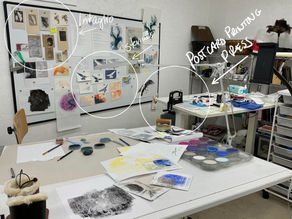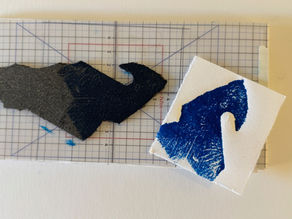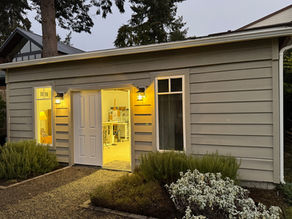Mammals in Museums
- Caroline Clarke

- Feb 27, 2024
- 2 min read

I take my drawings seriously. In a lighthearted sort of way for sure … but yes, I believe drawings matter. So, sometimes when drawing where people can see me, I hesitate before bringing out the colored pencil sticks. Like somehow I’m not “serious” if I draw in color? Doesn’t make sense, I know.
Actually, I’m bolder when I use the colored pencil sticks. Big swaths of colored shapes go down in a single go. And, because the sticks don’t erase, the entire path to finding the drawing accumulates on the page. So I usually bring the colored pencil sticks with me.
In the Smithsonian's Natural History Museum on any given morning, claiming a place to draw is its own act of boldness. No matter where you put yourself, you’re in the flow of traffic. Or perhaps it’s more accurate to say, you become one more animal to be observed by visitors streaming by. That day in the Hall of Mammals, I set up my stool against the wall around the corner from the main entrance. My drawing kit is within reach at my feet and a large taxidermied Alaskan moose is within view ahead to my left.
This is where the colored pencil sticks again come into play. I’m happily sketching when the latest rush of children enter the Mammal Hall, their eyes on the moose, the hippo, the hyena up ahead. From the corner of my eye, I see a few slow down as the color on my page catches their attention. Then, inevitably one circles back to stand next to me, not too close, and pretends not to be watching me.
That's all it takes. I’m drawing the moose — what about you, do you like to draw? They nod and we’re off to the races.
All the kids that stopped love to draw — most of them draw animals. (One boy did confess, I pretty much draw robots and cars.) A particularly lovely girl returned later with her mother to show me the lion she’d drawn. I use pencils. That day, she left the Museum with one of my graphite sticks in her hands.
Despite the crowds, the Natural History Museum really is a great place to draw. You’re warm and dry in February. And, as one mother says, the animals stay put — that’s way better than the zoo!
A closer look:

Bone Hall is one of the Museum’s most interesting places. Many of the skeletons there have been on view since 1881 — with the collection encompassing every major group of vertebrate animals.*
The first case you see as you enter displays the skeleton of a Homo sapiens next to a Gorilla gorilla (the western gorilla) next to a Pan troglodytes (chimpanzee) next to a Pongo pygmaeus (orangutan).
The youngest children get scared looking at the bones. The teenagers love them. One older boy passing by with a group of friends looked at my drawings. Two seconds later, he’d done an about-face to tell me, you draw really good, before disappearing again. Made my day.
*For more info about the Smithsonian’s specimen collection, including its acquisition history, management and ethical returns policy, visit the Smithsonian online.

























I just got around to reading the two blogs from Washington, D.C. You draw with words too. It was as if I were in the crowded galleries of the Smithsonian Natural H. Museum along with the children, trying to peek over your shoulder.
I so enjoyed your description of the curious children. Warms my heart that they engaged with you through your efforts to draw in a public place. Thank you for sharing your enthusiasm as well as theirs!